Monitoring of Particulate Matter Emissions from 3D Printing Activity in the Home Setting
Abstract
1. Introduction
2. Materials and Methods
2.1. 3D Printing Domestic Setting
2.2. 3D Printing Procedure
2.3. Particulate Matter Emission Monitoring
3. Results and Discussion
3.1. PM Emission Profiles Using Recommended Print Settings
3.2. Impact of Filament on PM Emissions
3.2.1. Filament Color
3.2.2. Filament Brand
3.3. The Impact of User-Controlled Print Settings on PM Emissions
3.3.1. Fan Speed
3.3.2. Infill Density
3.3.3. Extruder Temperature
3.4. Assessing the Usefulness of Low-Cost IAQ Sensors for PM Emission Monitoring during Home 3D Printing
4. Conclusions
Supplementary Materials
Author Contributions
Funding
Institutional Review Board Statement
Informed Consent Statement
Data Availability Statement
Conflicts of Interest
References
- Cincinelli, A.; Martellini, T. Indoor Air Quality, and Health. Int. J. Environ. Res. Public Health 2017, 14, 1286. [Google Scholar] [CrossRef]
- Jones, A. Indoor air quality and health. Atmos. Environ. 1999, 33, 4535–4564. [Google Scholar] [CrossRef]
- Kim, K.-H.; Kabir, E.; Kabir, S. A review on the human health impact of airborne particulate matter. Environ. Int. 2015, 74, 136–143. [Google Scholar] [CrossRef]
- Weichenthal, S. Selected physiological effects of ultrafine particles in acute cardiovascular morbidity. Environ. Res. 2012, 115, 26–36. [Google Scholar] [CrossRef]
- Schins, R.P.; Lightbody, J.H.; Borm, P.J.; Shi, T.; Donaldson, K.; Stone, V. Inflammatory effects of coarse and fine particulate matter in relation to chemical and biological constituents. Toxicol. Appl. Pharmacol. 2004, 195, 1–11. [Google Scholar] [CrossRef] [PubMed]
- Farmer, D.K.; Vance, M.E.; Abbatt, J.P.D.; Abeleira, A.; Alves, M.R.; Arata, C.; Boedicker, E.; Bourne, S.; Cardoso-Saldaña, F.; Corsi, R.; et al. Overview of HOMEChem: House Observations of Microbial and Environmental Chemistry. Environ. Sci. Process. Impacts 2019, 21, 1280–1300. [Google Scholar] [CrossRef] [PubMed]
- Bravi, L.; Murmura, F.; Santos, G. Additive Manufacturing: Possible Problems with Indoor Air Quality. Proc. Manuf. 2019, 41, 952–959. [Google Scholar] [CrossRef]
- Rayna, T.; Striukova, L. From rapid prototyping to home fabrication: How 3D printing is changing business model innovation. Technol. Forecast. Soc. Chang. 2016, 102, 214–224. [Google Scholar] [CrossRef]
- Mumith, A.; Thomas, M.; Shah, Z.; Coathup, M.; Blunn, G. Additive manufacturing current concepts, future trends. Bone Jt. J. 2018, 100B, 455–460. [Google Scholar] [CrossRef]
- Chýlek, R.; Kudela, L.; Pospíšil, J.; Šnajdárek, L. Fine particle emission during fused deposition modelling and thermogravimetric analysis for various filaments. J. Clean. Prod. 2019, 237, 117790. [Google Scholar] [CrossRef]
- Azimi, P.; Zhao, D.; Pouzet, C.; Crain, N.E.; Stephens, B. Emissions of Ultrafine Particles and Volatile Organic Compounds from Commercially Available Desktop Three-Dimensional Printers with Multiple Filaments. Environ. Sci. Technol. 2016, 50, 1260–1268. [Google Scholar] [CrossRef] [PubMed]
- Cheng, Y.-L.; Zhang, L.-C.; Chen, F.; Tseng, Y.-H. Particle Emissions of Material-Extrusion-Type Desktop 3D Printing: The Effects of Infill. Int. J. Precis. Eng. Manuf. Technol. 2018, 5, 487–497. [Google Scholar] [CrossRef]
- Ding, S.; Ng, B.F.; Shang, X.; Liu, H.; Lu, X.; Wan, M.P. The characteristics and formation mechanisms of emissions from thermal decomposition of 3D printer polymer filaments. Sci. Total. Environ. 2019, 692, 984–994. [Google Scholar] [CrossRef] [PubMed]
- Stabile, L.; Scungio, M.; Buonanno, G.; Arpino, F.; Ficco, G. Airborne particle emission of a commercial 3D printer: The effect of filament material and printing temperature. Indoor Air 2017, 27, 398–408. [Google Scholar] [CrossRef] [PubMed]
- Sittichompoo, S.; Kanagalingam, S.; Thomas-Seale, L.; Tsolakis, A.; Herreros, J. Characterization of particle emission from thermoplastic additive manufacturing. Atmos. Environ. 2020, 239, 117765. [Google Scholar] [CrossRef]
- Zhou, Y.; Kong, X.; Chen, A.; Cao, S. Investigation of Ultrafine Particle Emissions of Desktop 3D Printers in the Clean Room. Proc. Eng. 2015, 121, 506–512. [Google Scholar] [CrossRef]
- Afshar-Mohajer, N.; Wu, C.-Y.; Ladun, T.; Rajon, D.A.; Huang, Y. Characterization of particulate matters and total VOC emissions from a binder jetting 3D printer. Build. Environ. 2015, 93, 293–301. [Google Scholar] [CrossRef]
- Deng, Y.; Cao, S.-J.; Chen, A.; Guo, Y. The impact of manufacturing parameters on submicron particle emissions from a desktop 3D printer in the perspective of emission reduction. Build. Environ. 2016, 104, 311–319. [Google Scholar] [CrossRef]
- Davis, A.Y.; Zhang, Q.; Wong, J.P.; Weber, R.J.; Black, M.S. Characterization of volatile organic compound emissions from consumer level material extrusion 3D printers. Build. Environ. 2019, 160, 106209. [Google Scholar] [CrossRef]
- Gu, J.; Wensing, M.; Uhde, E.; Salthammer, T. Characterization of particulate and gaseous pollutants emitted during operation of a desktop 3D printer. Environ. Int. 2019, 123, 476–485. [Google Scholar] [CrossRef]
- Kwon, O.; Yoon, C.; Ham, S.; Park, J.; Lee, J.; Yoo, D.; Kim, Y. Characterization and Control of Nanoparticle Emission during 3D Printing. Environ. Sci. Technol. 2017, 51, 10357–10368. [Google Scholar] [CrossRef]
- Kim, Y.; Yoon, C.; Ham, S.; Park, J.; Kim, S.; Kwon, O.; Tsai, P.-J. Emissions of Nanoparticles and Gaseous Material from 3D Printer Operation. Environ. Sci. Technol. 2015, 49, 12044–12053. [Google Scholar] [CrossRef] [PubMed]
- Jeon, H.; Park, J.; Kim, S.; Park, K.; Yoon, C. Effect of nozzle temperature on the emission rate of ultrafine particles during 3D printing. Indoor Air 2019, 30, 306–314. [Google Scholar] [CrossRef] [PubMed]
- Vance, M.E.; Pegues, V.; Van Montfrans, S.; Leng, W.; Marr, L.C. Aerosol Emissions from Fuse-Deposition Modeling 3D Printers in a Chamber and in Real Indoor Environments. Environ. Sci. Technol. 2017, 51, 9516–9523. [Google Scholar] [CrossRef] [PubMed]
- Zhang, Q.; Pardo, M.; Rudich, Y.; Kaplan-Ashiri, I.; Wong, J.P.S.; Davis, A.Y.; Black, M.S.; Weber, R.J. Chemical Composition and Toxicity of Particles Emitted from a Consumer-Level 3D Printer Using Various Materials. Environ. Sci. Technol. 2019, 53, 12054–12061. [Google Scholar] [CrossRef]
- Byrley, P.; George, B.J.; Boyes, W.K.; Rogers, K. Particle emissions from fused deposition modeling 3D printers: Evaluation and meta-analysis. Sci. Total. Environ. 2019, 655, 395–407. [Google Scholar] [CrossRef]
- McDonnell, B.; Xavier Jimenez, G.; Dolack, M.; Simpson, T.W.; Cimbala, J.M. 3D Printing in the Wild: A Preliminary Investigation of Air Quality in College Maker Spaces. In Proceedings of the 27th Annual International Solid Freeform Fabrication Symposium—An Additive Manufacturing Conference 2016, Austin, TX, USA, 8–10 August 2016; pp. 2456–2469. [Google Scholar]
- Department of Housing Planning and Local Government Buildings Regulations 2019 Technical Guidance Document F Ventilation; Department of Housing Planning and Local Government Buildings: Dublin, Ireland, 2019.
- Lee, K.W.; Liu, B.Y.H. On the Minimum Efficiency and the Most Penetrating Particle Size for Fibrous Filters. J. Air Pollut. Control. Assoc. 1980, 30, 377–381. [Google Scholar] [CrossRef]
- Mendes, L.; Kangas, A.; Kukko, K.; Mølgaard, B.; Säämänen, A.; Kanerva, T.; Ituarte, I.F.; Huhtiniemi, M.; Stockmann-Juvala, H.; Partanen, J.; et al. Characterization of Emissions from a Desktop 3D Printer. J. Ind. Ecol. 2017, 21, S94–S106. [Google Scholar] [CrossRef]
- Stefaniak, A.; Johnson, A.; Du Preez, S.; Hammond, D.; Wells, J.; Ham, J.; LeBouf, R.; Menchaca, K.; Martin, S.; Duling, M.; et al. Evaluation of emissions and exposures at workplaces using desktop 3-dimensional printers. J. Chem. Health Saf. 2019, 26, 19–30. [Google Scholar] [CrossRef]
- Chojer, H.; Branco, P.; Martins, F.; Alvim-Ferraz, M.; Sousa, S. Development of low-cost indoor air quality monitoring devices: Recent advancements. Sci. Total. Environ. 2020, 727, 138385. [Google Scholar] [CrossRef]
- Tiele, A.; Esfahani, S.; Covington, J. Design and Development of a Low-Cost, Portable Monitoring Device for Indoor Environment Quality. J. Sens. 2018, 2018, 1–14. [Google Scholar] [CrossRef]
- Williams, D.E. Low-Cost Sensor Networks: How Do We Know the Data Are Reliable? ACS Sens. 2019, 4, 2558–2565. [Google Scholar] [CrossRef] [PubMed]



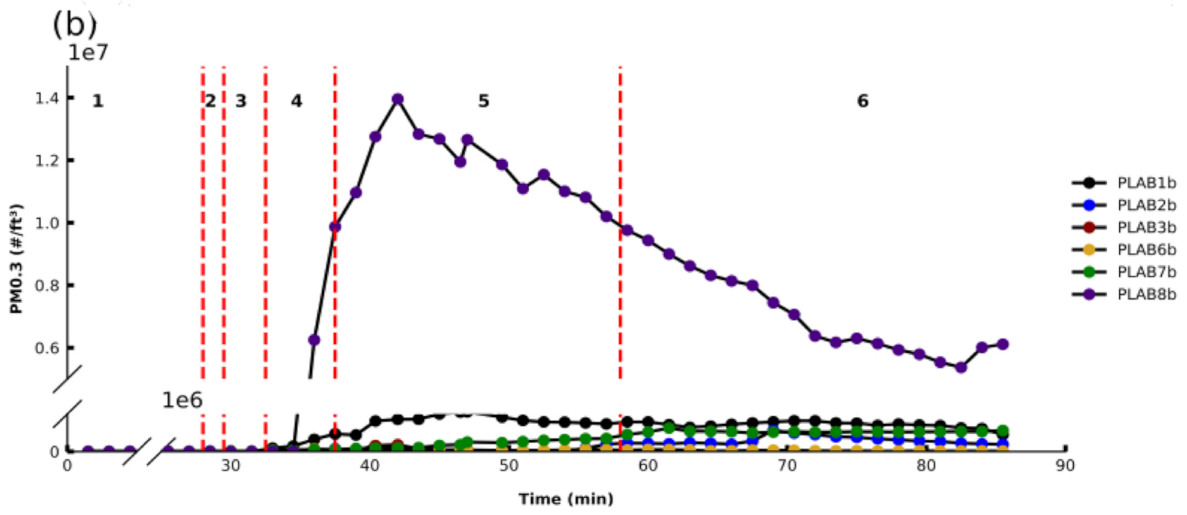
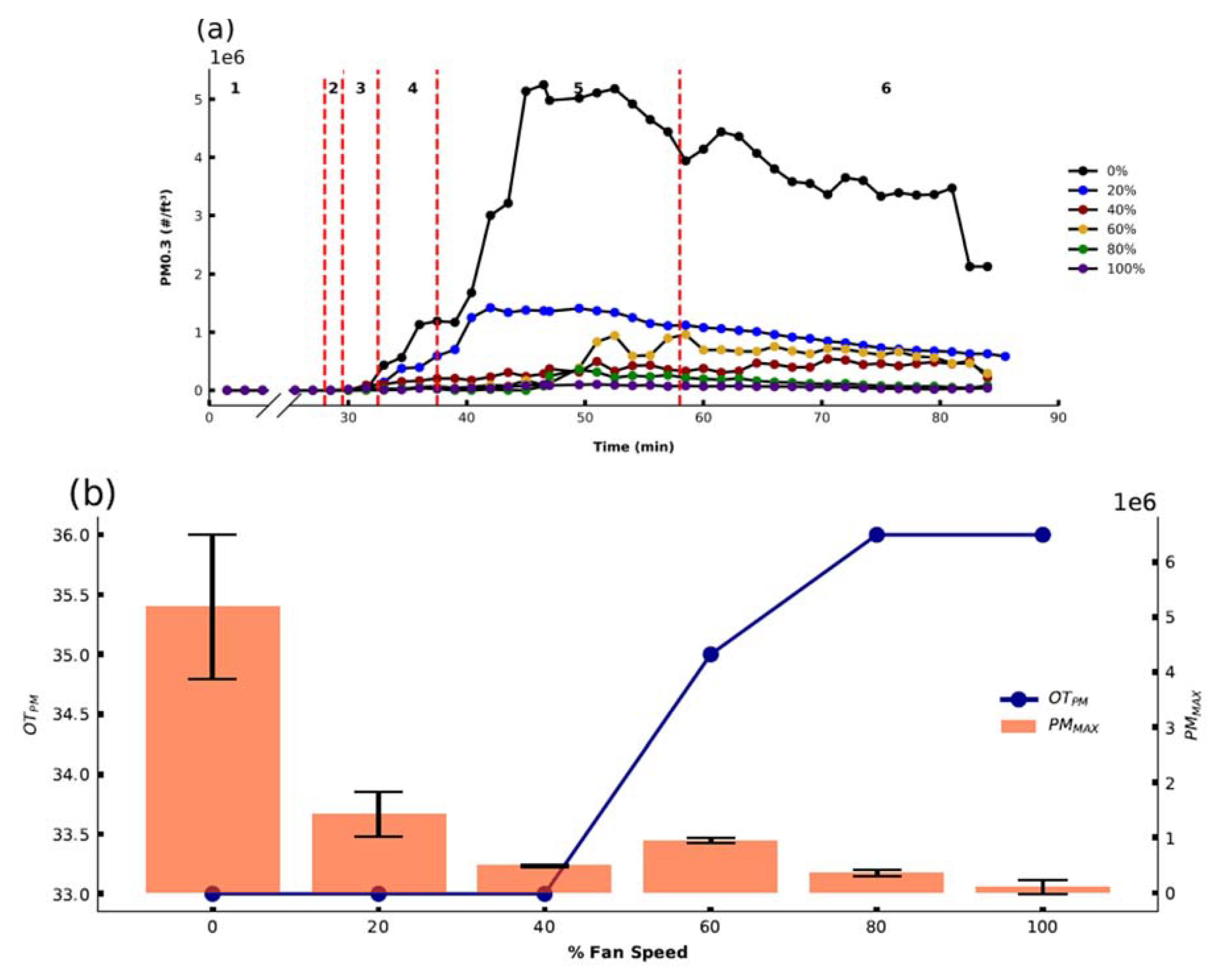
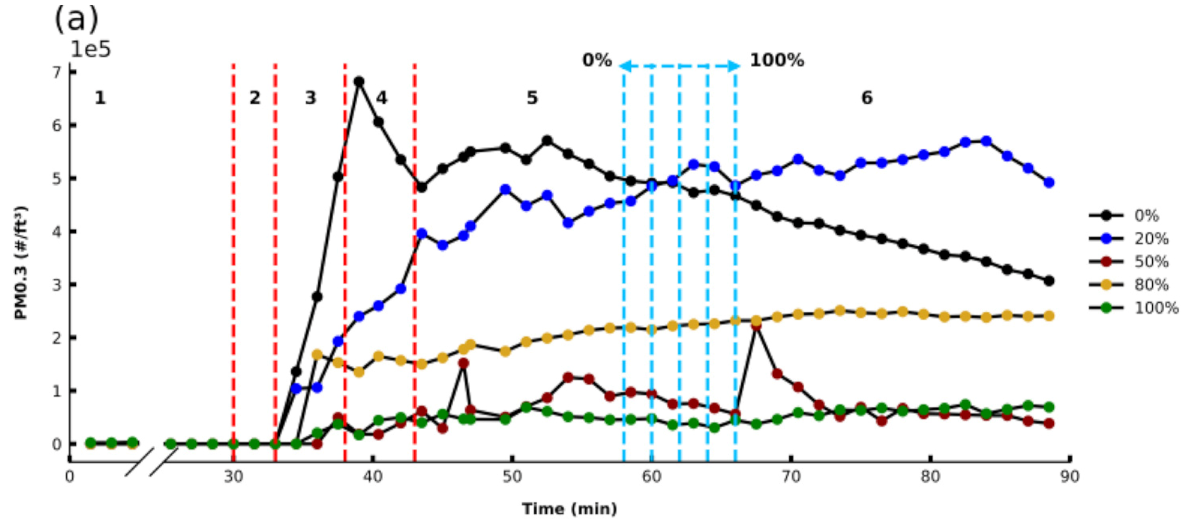
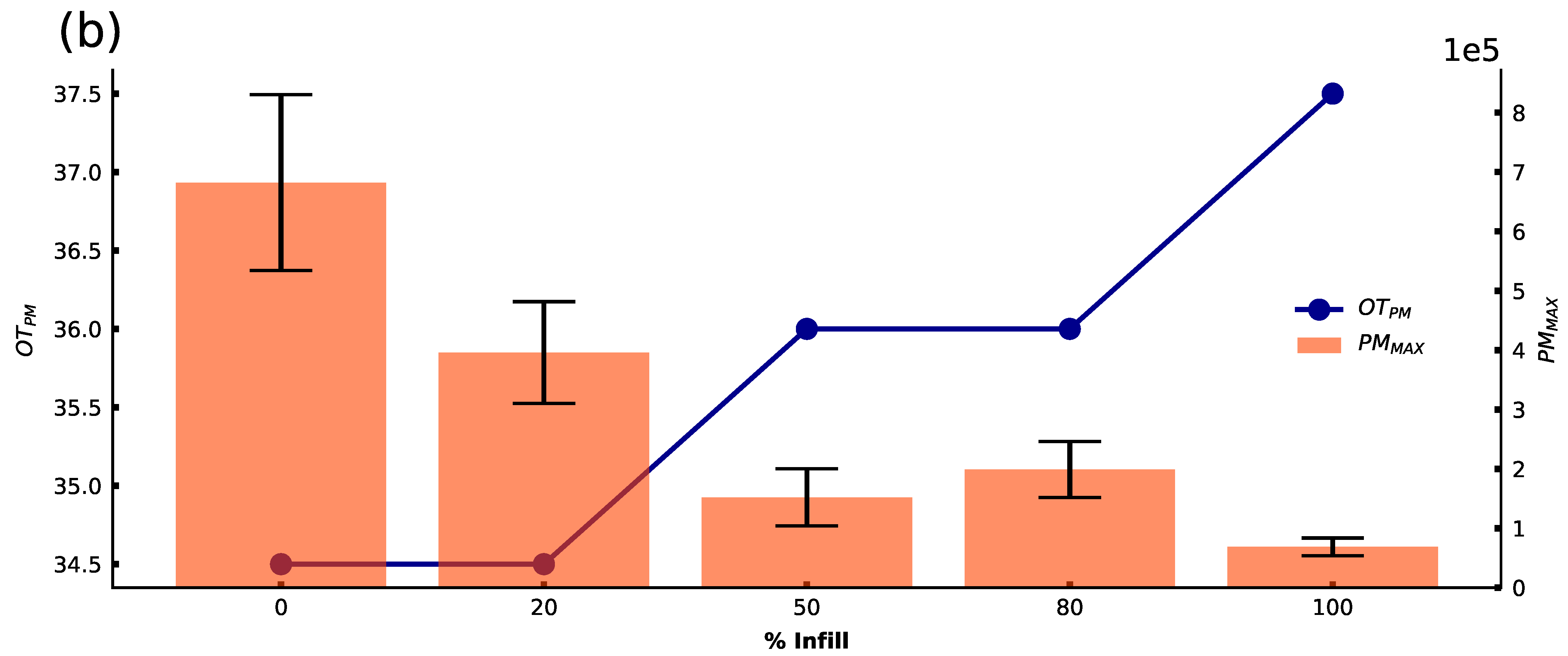
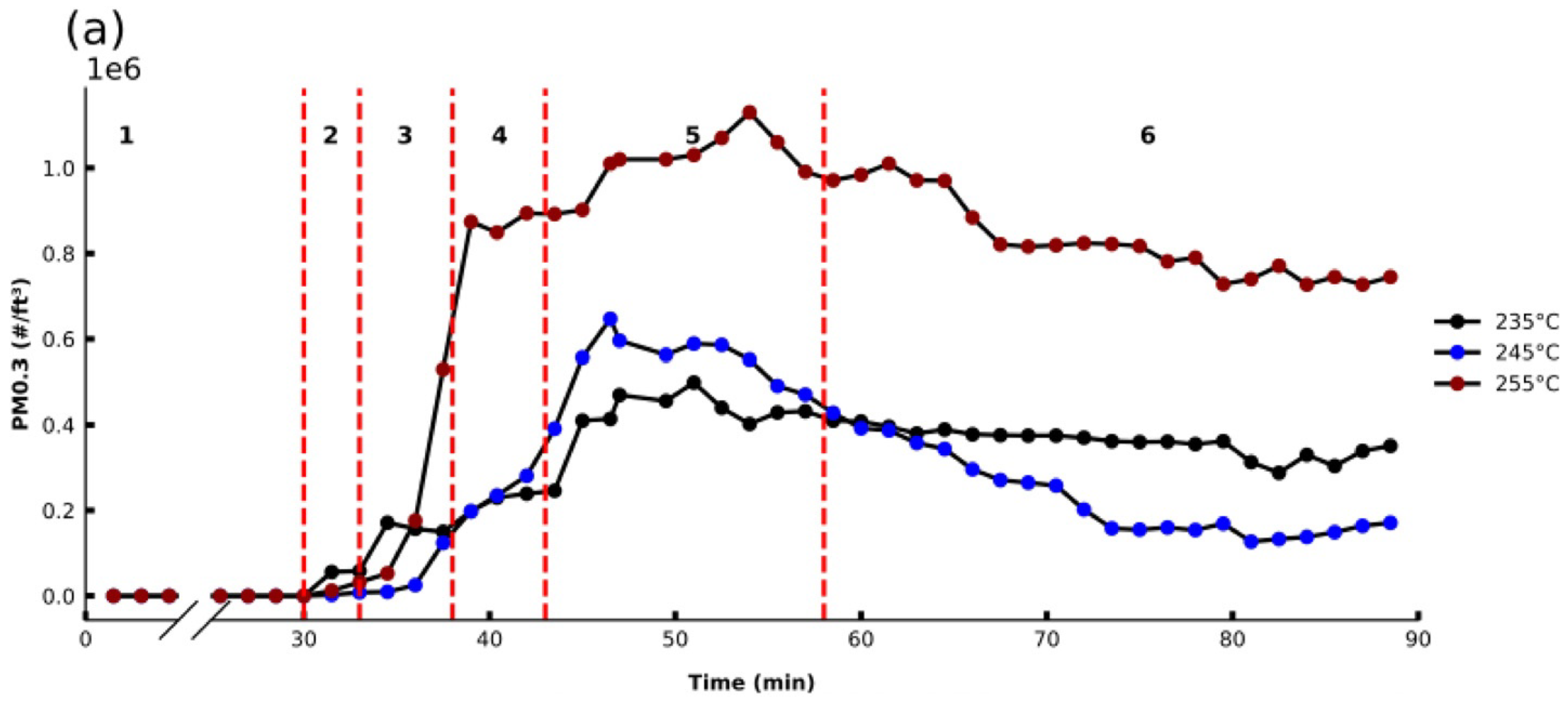


| Print Settings | Value |
|---|---|
| Print speed (mm/s) * | 50 |
| Filament diameter (mm) * | 1.75 |
| Bed temperature (°C) * | 80 (ABS) 50 (PLA) |
| Filament color | white, yellow, black |
| Cooling fan speed (%) | 0, 20, 40, 60, 80, 100 |
| Infill density (%) | 0, 20, 50, 80, 100 |
| Extruder temperature (°C) | 235–255 (ABS) 205–220 (PLA) |
| Filament | Brand | Color | Code |
|---|---|---|---|
| ABS | 1 | Black | ABSB1b |
| ABS | 2 | Black | ABSB2b |
| ABS | 3 | Black | ABSB3b |
| ABS | 4 | Black | ABSB4b |
| ABS | 5 | Black | ABSB5b |
| ABS | 5 | White | ABSB5w |
| ABS | 5 | Yellow | ABSB5y |
| PLA | 1 | Black | PLAB1b |
| PLA | 2 | Black | PLAB2b |
| PLA | 3 | Black | PLAB3b |
| PLA | 4 | Black | PLAB6b |
| PLA | 5 | Black | PLAB7b |
| PLA | 6 | Black | PLAB8b |
| PLA | 6 | White | PLAB8w |
| PLA | 6 | Yellow | PLAB8y |
Publisher’s Note: MDPI stays neutral with regard to jurisdictional claims in published maps and institutional affiliations. |
© 2021 by the authors. Licensee MDPI, Basel, Switzerland. This article is an open access article distributed under the terms and conditions of the Creative Commons Attribution (CC BY) license (https://creativecommons.org/licenses/by/4.0/).
Share and Cite
Khaki, S.; Duffy, E.; Smeaton, A.F.; Morrin, A. Monitoring of Particulate Matter Emissions from 3D Printing Activity in the Home Setting. Sensors 2021, 21, 3247. https://doi.org/10.3390/s21093247
Khaki S, Duffy E, Smeaton AF, Morrin A. Monitoring of Particulate Matter Emissions from 3D Printing Activity in the Home Setting. Sensors. 2021; 21(9):3247. https://doi.org/10.3390/s21093247
Chicago/Turabian StyleKhaki, Shirin, Emer Duffy, Alan F. Smeaton, and Aoife Morrin. 2021. "Monitoring of Particulate Matter Emissions from 3D Printing Activity in the Home Setting" Sensors 21, no. 9: 3247. https://doi.org/10.3390/s21093247
APA StyleKhaki, S., Duffy, E., Smeaton, A. F., & Morrin, A. (2021). Monitoring of Particulate Matter Emissions from 3D Printing Activity in the Home Setting. Sensors, 21(9), 3247. https://doi.org/10.3390/s21093247






